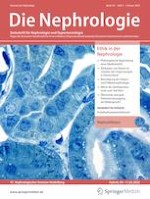07.02.2023 | Urolithiasis | CME
Pathogenese, Progression und Metaphylaxe der Nephrolithiasis
Im Fokus: Kalziumnephrolithiasis
Erschienen in: Die Nephrologie | Ausgabe 2/2023
Einloggen, um Zugang zu erhaltenZusammenfassung
Die Prävalenz der Nephrolithiasis ist weltweit steigend. Eine zentrale Rolle bei der Steinbildung und -progression spielt dabei die Zusammensetzung des Urins, welche durch Ernährung, Lebensstil, genetische Prädisposition und erworbene Erkrankungen beeinflusst werden kann. Epidemiologische Studien konnten dabei einen Zusammenhang zwischen Nierensteinen und Übergewicht, metabolischem Syndrom und Insulinresistenz nachweisen. Auch inflammatorische Prozesse und Einflüsse durch das Mikrobiom werden derzeit diskutiert. Die vorliegende Arbeit fasst die wesentlichen Risikofaktoren einer Nephrolithiasis zusammen und erläutert sich daraus ableitende Therapieoptionen der rezidivierenden Nephrolithiasis, welche Allgemeinmaßnahmen und eine medikamentöse Metaphylaxe umfassen. Der vorliegende Artikel legt dabei einen besonderen Schwerpunkt auf die häufigste Steinart, die Kalziumnephrolithiasis, gibt aber auch einen Überblick über seltenere Nierensteinerkrankungen.











